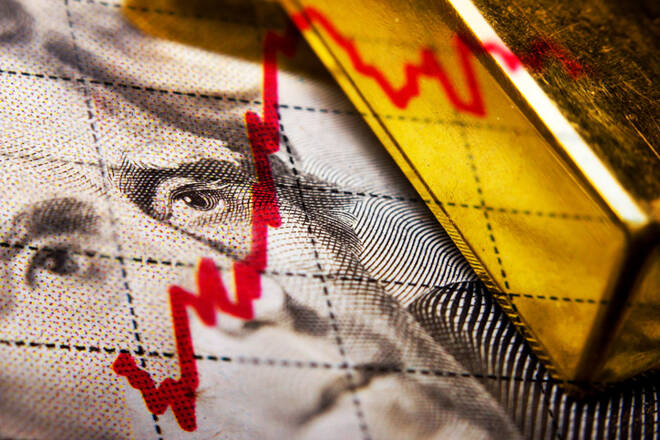Advertisement
Advertisement
Price of Gold Fundamental Daily Forecast – Supported by Global Recession Concerns
By:
Gold is trading higher, but the market remains inside yesterday’s wide range. The heightened volatility may have shook up traders a little, who seem to be a little reluctant to chase prices higher at current price levels. Nonetheless, the news is bullish for gold prices for the long run.
Gold prices are edging higher on Wednesday after reversing earlier weakness. The strength is being fueled by a weaker dollar, lower demand for risky assets and plunging U.S. Treasury yields. The catalysts behind the price action are weak economic data from China and the Euro Zone. The 2-year and 10-year U.S. Treasury yields also inverted, flashing an early sign of a recession.
At 12:53 GMT, December Comex gold is trading $1525.60, up $11.40 or +0.73%.
“We got some poor Chinese data out, we’re seeing some slowing there, and the German data showing that the economy contracted in the second quarter so, all these slowdown concerns support gold,” ING analyst Warren Patterson said.
Key Treasury Yield Inversion Signals Recession.
On Wednesday, the yield on the benchmark 10-year Treasury note broke below the 2-year rate, a reliable early indicator for economic recessions. The yield on the U.S. 30-year bond fell to a new all-time low, dropping past its prior record notched in the summer of 2016.
Traders see a 76% chance of a 25-basis point rate cut by the U.S. central bank next month.
China Industrial Output Lower Than Forecast
Gold prices began to strengthen early Wednesday after data from the National Bureau of Statistics in China showed the country’s industrial output in July rising at its slowest in 17 years.
Industrial output rose 4.8% in July as compared to a year earlier, official data showed, its slowest since February 2002. Traders were looking for 5.8% growth. Retail sales growth was also lower than expected, rising 7.6% in July from a year earlier. Traders were looking for an 8.6% gain.
Euro Zone Gross Domestic Product Meets Expectations
Gold buyers were also influenced by a report showing a contraction for the export-reliant German economy in the second quarter. The news served as a reminder that the prolonged trade war between the United States and China was dragging down the Euro Zone economy.
German Preliminary GDP came in at -0.1%, meeting expectations. Euro Zone Flash GDP also came in as expected at 0.2%. However, Euro Zone Industrial Production fell 1.6%, more than the 1.4% estimate. The previous month was revised lower to 0.8%.
Daily Forecast
Gold is trading higher, but the market remains inside yesterday’s wide range. The heightened volatility may have shook up traders a little, who seem to be a little reluctant to chase prices higher at current price levels. Nonetheless, the news is bullish for gold prices for the long run.
Although gold doesn’t pay interest, it will continue to be an attractive asset as the world’s central bank’s move closer to negative interest rates. It’s better to be paid nothing than to pay a government interest to borrow your money.
According to data from Credit Suisse going back to 1978 shows:
- The last five 2-10 inversions have eventually led to recessions.
- A recession occurs, on average, 22 months following a 2-10 inversion.
- The S&P 500 is up, on average, 12% one year after a 2-10 inversion.
- It’s not until about 18 months after an inversion when the stock market usually turns and posts negative returns.
About the Author
James Hyerczykauthor
James Hyerczyk is a U.S. based seasoned technical analyst and educator with over 40 years of experience in market analysis and trading, specializing in chart patterns and price movement. He is the author of two books on technical analysis and has a background in both futures and stock markets.
Did you find this article useful?
Latest news and analysis
Advertisement
